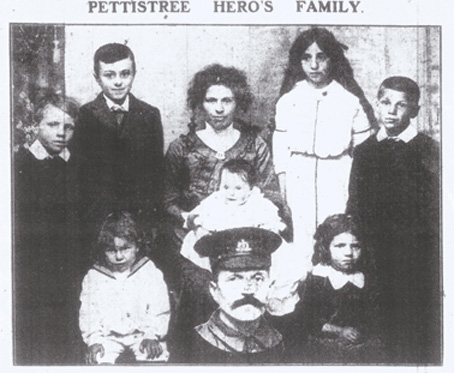Samuel was born on 21st May 1879 in Brewers Lane in Woodbridge. At the age of twenty-one, he was working with his stepfather, Francis, as a stoker at St Audry’s Hospital. On the 29th July 1901, he was married to Annie Norris in St Andrews Church, Melton, and moved to Bredfield, where their first child, Elsie, was born. By 1911, Samuel and Annie had four more children and were still living at Pump Corner, Bredfield. Three years later in 1914, the family had moved to Brick Kiln Cottages, in Pettistree, and Samuel continued to work as a stoker at St Audry’s.
When war was declared, Samuel decided to enlist and, in October 1914, he joined the 7th (Service) Battalion, Suffolk Regiment, based in Shorncliffe in Kent. In February 1915, the battalion moved to Aldershot Barracks, where they underwent further training. The battalion proved to be adept at shooting and were rated the best battalion in the brigade musketry course.
Samuel and the 7th Suffolks received orders sending them to France on 30th May 1915. They entrained for Folkestone, where they boarded the SS Invicta and SS Queen for the journey to Boulogne. Once in France, they were sent to the Ypres salient in Belgium, where they spent the summer months in the front line at Ploegsteert. At the end of September though, it was all change and the battalion was sent south, to take part in the Battle of Loos on 10th October 1915.
At the beginning of July 1916, Samuel found himself on the front line at The Somme, where the 7th Suffolks lead in the attack on Ovillers-La-Boisselle. Some members of the battalion managed to get into the village but, due to a lack of support and ammunition, were forced back by the German army. By the end of the day, the 7th Suffolks had suffered four hundred and seventy casualties, including all their company commanders.
In October 1916, the battalion had moved to Guedecourt and, on the 10th, they were sent to the front line at Bull’s Run, near Flers, with orders to capture Bayonet Trench and Luisenhof Farm in the opening action of the Battle of Transloy. The attack was to be a disaster for the 7th Suffolks; the artillery barrage had not cut the enemy barbed wire and supporting fire from them was ineffective. Some men managed to get close to the German trenches but were held back by machine gun fire and the uncut barbed wire. The battalion suffered badly that day sustaining over five hundred casualties, one of whom was Lance Serjeant Samuel Berry. His body was not recovered from the battlefield and he is remembered on the Thiepval Memorial, Pettistree War Memorial and at St Andrew’s Church, Melton.
For his war service, Samuel’s family received his 1914-15 Star and the British War and Victory Medals.

